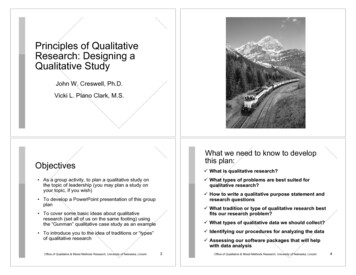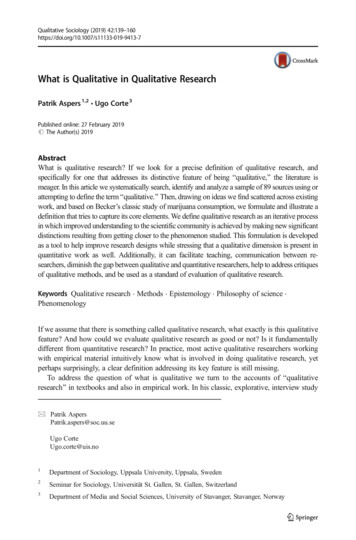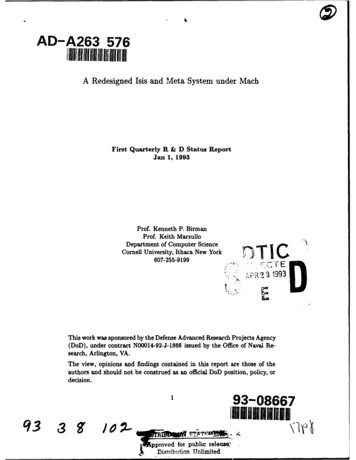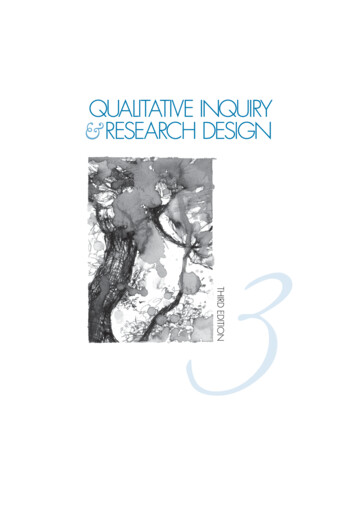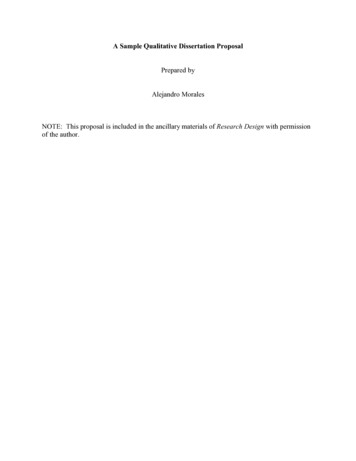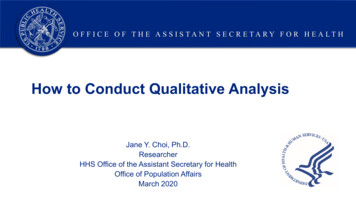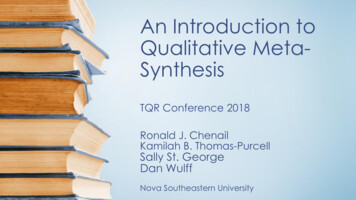
Transcription
An Introduction toQualitative MetaSynthesisTQR Conference 2018Ronald J. ChenailKamilah B. Thomas-PurcellSally St. GeorgeDan WulffNova Southeastern University
AbstractSystematic reviews of published qualitative research haveemerged as an important set of methods to aggregate,summarize, analyze, and synthesize qualitative data from a varietyof study designs. These approaches include meta-study, metasummary, grounded formal theory, meta-ethnography, andqualitative meta-synthesis. In this workshop, we will focus onqualitative meta-synthesis by presenting a six-step approach forconducting this type of systematic review and sharing ourprocedures and results from our own studies.
Learning Outcomes1.Comprehend the importance ofsystematic reviews of researchliterature2.Define qualitative metasynthesis3.Identify and utilize the stepsinvolved in conducting aqualitative metasynthesis
Systematic Reviews
Narrative Literature Reviews Broad literature reviews ofpreviously published research Review method not typicallyreported Descriptive, Interpretive, and/orCritical Review Report a story of the literature
Systematic Reviews Literature reviews adhering closely toa set of scientific methods which arereported as part of the review report Explicitly aimed to limit systematicerror (bias) Rigorous attempt to identify,appraise, and synthesize all relevantstudies (of whatever design) in orderto answer a particular question (orset of questions)(Pettigrew & Roberts, 2006, p. 9) Research (meta) of previousresearch (primary)
Evidence Pyramid
Conducting a Systematic Review Requires a team approach Considerable commitment fromteam members Members need to clarify eachperson’s contributions What does each member hopeto gain from participation
Reflective Questions What is the purpose of conducting thesystematic review? Who is the intended audience of thefindings? Who will use the products? Who will be the members of the teamand how will team members beselected?(Paterson, Thorne, Canam, & Jillings, 2001)
Reflective Questions Do the reviewers have thenecessary resources to accessprimary research reports? Do reviewers have the enough time,space and expertise to conduct thesystematic review? How will team members relate andinteract with each other? (Paterson,Thorne, Canam, & Jillings, 2001)
Reflective Questions What will be the role of theprimary investigator? How will conflicts and/ordiffering points of view beresolved among the researchteam? (Paterson, Thorne, Canam, &Jillings, 2001)
Determining the Purpose of theSystematic Review Directs the review question Develops from readingresearch within the field Identifies questions aboutassumptions of the work(Paterson, Thorne, Canam, & Jillings, 2001)
Formulating a Review Question May relate to a broad ornarrow phenomenon A broad focus permits afocus on the overallphenomenon as well asrelated ones A narrow focus limits theconcentration of the scopeof research available to thereviewers (Paterson, Thorne, Canam &Jillings, 2001)
Research Synthesis
Research Synthesis A technique for synthesizing the results ofprimary research studies both quantitativelyand qualitatively (Cooper, 1998, p. 4) Integrating findings to reach a newtheoretical or conceptual level ofunderstanding and development– Integration– More than the sum of parts– Inferences derived from findings as a whole– New higher-order interpretations created (Thorne,Jensen, Kearney, Noblit, & Sandelowski, 2004)
Types of Systematic ResearchSynthesis Reviews Meta-Analysis Meta-Ethnography Grounded Formal Theory Meta-Study Qualitative Metasummary Qualitative Metasynthesis
Systematic Research SynthesisReviewsMeta-AnalysisA statistical technique foraggregating and integratingthe results of primary researchstudies quantitatively (Cooper, 1998)Qualitative MetasummaryA quantitative oriented aggregationof qualitative findings that arethemselves topical or thematicsummaries or surveys of data(Sandelowski & Barroso, 2007, p. 151)
Systematic Research SynthesisReviewsMeta-EthnographyGrounded Formal TheoryThe focus is on constructinginterpretations, not analyzingthe dataAnalyze inductively andinterpret theory, methods, andresearch findings acrossqualitative studies (Glaser, 2006;Glaser & Strauss, 1967)Often look for “metaphors” ascategories or descriptors (e.g.,Campbell et al., 2003; Noblit & Hare, 1988)Synthesize this work to formulatenew interpretations (Finfgeld, 2003;Thorne, Jensen, Kearney, Noblit, & Sandelowski,2004)
Systematic Research SynthesisReviews: Meta-Study Meta-Data-Analysis Meta-Method Meta-Theory Meta-Synthesis (Paterson, Thorne,Canam, & Jillings, 2001)
QualitativeMetasynthesis
Qualitative MetasynthesisQualitative metasynthesis is anintentional and coherent approachto analyzing data across qualitativestudies. It is a process that enablesresearchers to identify a specificresearch question and then searchfor, select, appraise, summarize, andcombine qualitative evidence toaddress the research question. Thisprocess uses rigorous qualitativemethods to synthesize existingqualitative studies to constructgreater meaning through aninterpretative process. (Erwin, Brotherson, &Summers, 2010, p. 186)
Qualitative MetasynthesisAn interpretation of qualitativefindings that are themselvesinterpretive syntheses of dataincluding phenomenologies,ethnographies, groundedtheories, and other integratedand coherent descriptions orexplanations of phenomena,events, or cases that are thehallmarks of qualitativeresearch (Sandelowski & Barroso, 2007, p.151)
Reasons for QualitativeMetasynthesisThe move toward evidencebased practice has been apositive impetus to alignqualitative research andresearch synthesis efforts(Sandelowski & Barroso, 2007)Allows for a collective way ofviewing specific researchwithin a discipline andintegrating the findings into aform that is readily accessibleand understandable.
Conducting aQualitativeMetasynthesis
Sandelowski & Barroso’sQualitative Metasynthesis
Qualitative Metasynthesis ExamplesRon Chenail, Sally St. George,Dan Wulff, Maureen Duffy,Karen Wilson Scott, & Karl Tomm2012Clients’ Relational Conceptionsof Conjoint Couple and FamilyTherapy Quality: A GroundedFormal TheoryJournal of Marital and FamilyTherapy, 38(1), 241-264.
Qualitative Metasynthesis ExamplesKamilah Thomas-Purcell2018Exploring Religion andSpirituality as a Key toAddressing Cultural Barriers toHealth Literacy
Sandelowski & Barroso’s Six Steps or Stagesof a Qualitative Metasynthesis1. Formulating the reviewquestion4. Analyzing and synthesizingqualitative findings2. Conducting a systematicliterature search5. Maintaining quality control3. Screening and selectingappropriate researcharticles6. Presenting findings (Sandelowski &Barroso, 2003, 2007)
1. Formulating the Review Question PICO: Population, Intervention, Comparison and Outcomes SPICE: Setting, Perspective, Intervention/Phenomena of Interest,Comparison, and Evaluation (Booth, 2006) Metasynthesis Examples– To integrate published knowledge in order to draw conclusions forpractice– To address apparent discrepant findings by providing a newinterpretation (Petticrew & Roberts, 2006)
Our review questionsChenail et al., 2012Thomas-Purcell, 2018From a metasynthesis of thepublished research, whatinductive theory can be builtregarding clients’ experiencesof their conjoint couple orfamily therapy?From a metasynthesis of thepublished research, whatinductive theory can be builtregarding African Americanpatients’ perceptions of the roleof religion/spirituality in themanagement of chronicdisease?
2. Conducting a SystematicLiterature Search Reviewer selects key words to guide the literature search The parameters of who, what, and time establish the inclusionand exclusion criteria. Throughout the search the reviewer continually re-evaluates thedefinitions of the search terms or the time frame
Our literature searchesChenail et al., 2012Thomas-Purcell, 2018 Databases: Google Scholar, EBSCOhost, Family & Society StudiesWorldwide, ProQuest PsychologyJournals, PsycARTICLES, and PsycInfo Databases: Applied SocialSciences Index & Abstracts (ASSIA),PsychInfo, JSTOR, ProQuest Central,Science Direct, CINAHL, Medline Journals: Family Process, Journal ofFamily Therapy, Journal of Maritaland Family Therapy Search Terms: spirituality, religion,African Americans, chronicdisease, qualitative Search Terms: client experience,client perspective, marriage andfamily therapy, couple therapy,family counseling, and qualitativeresearch Span: 2000-2017 Span: 1990-2010
3. Screening and SelectingAppropriate Research Articles Identify studies Review to determine if they meet the inclusion criteriaset prior to beginning the search
Our screening processChenail et al., 2012Thomas-Purcell, 2018Created an Inclusion or ExclusionCriteria Form to determinewhether or not each study (a)contained qualitative evidencefrom clients to support the findings(e.g., direct quotes from interviewsor questionnaires) and (b) focusedon conjoint couple or familytherapy being delivered to clientsconsisting of more than onemember of the family being seenin sessions together.Created an Inclusion or ExclusionCriteria Form to determinewhether or not each study (a)contained qualitative evidencefrom patients or health careproviders to support findings (e.g.,direct quotes from interviews orquestionnaires) and (b)focused onreligion and spirituality amongAfrican Americans.
4. Evaluating Research Studies Several checklists exist for the purpose of evaluatingqualitative research studies Tool to appraise the quality of primary qualitativeresearch studies is the Critical Appraisal SkillsProgramme (CASP, 2017) 10 Questions to Help YouMake Sense of Qualitative Research
Critical Appraisal Skills Programme(CASP, 2017) Developed specifically for individuals new toqualitative research Guide the reviewer through the appraisalprocess Helps to determine rigor, credibility andrelevance of qualitative research studies
Critical Appraisal Skills Programme(CASP, 2017) The questions focus on:––––––––The research designSampling strategyData collectionReflexivity which includes the relationship between the researcher and theparticipantsEthical considerationsRigor of the data analysisClear statement of the findingsValue of the research. Tool is available at http://www.casp-uk.net/casp-tools-checklists
Our evaluationsChenail et al., 2012Thomas-Purcell, 2018 Critical Appraisal SkillsProgramme’s (CASP, 2017)“10 Questions to Help YouMake Sense of QualitativeResearch” Critical Appraisal SkillsProgramme’s (CASP, 2017)“10 Questions to Help YouMake Sense of QualitativeResearch” CASP Rubric and SummaryForm (Chenail, 2008) CASP Rubric and SummaryForm (Thomas-Purcell, 2018) Sample: From 85 to 49 articles Sample: From 111 to #TBDarticles?
Classifying the Findings Typology of qualitative findings from closest to data from farthest fromdata– No finding: Not research (exclude)– Topical survey: Not qualitative research(qualitative metasummary)– Thematic survey: Exploratory qualitative research (qualitativemetasummary)– Conceptual/thematic description: Descriptive qualitative research(qualitative metasynthesis)– Interpretative explanation: Explanatory qualitative research (qualitativemetasynthesis) (Sandelowski & Barroso, 2007)
Extraction of Findings Data extraction entails separating in situ findings, or the findingsproduced within the confines of a reported study, in every report Analytic procedures, or the coding schemes and data displaysused to produce findings Researchers’ discussion of the meaning, implications, orsignificance of their findings Don’t extract findings not supported by data (Sandelowski & Barroso, 2007)
Editing of Findings Edit findings to make them as accessible as possible to anyreader Only minor editing is required (e.g., change phrases to completesentences) (Sandelowski & Barroso, 2007)
Grouping Findings Group findings that appear to be about the same topic Render Judgment:– Sameness– Difference– Confirmation– Extension– Refutation (Sandelowski & Barroso, 2007)
Abstracting Findings Categorization Concise statements Comprehensively captures the content (Sandelowski & Barroso, 2007)
Our extractionsChenail et al., 2012Thomas-Purcell, 2018Created a simple cross-study display forcomparative to extract, review and analyzecritical information from their articles:Will create data tables to extract data direct totables to review and analyze studycharacteristics, methodological quality andfindings of articles Full article citation Clinical context of the research participants(e.g., treatment setting, clinical approach, andclient characteristics). Key methodological information such asresearch goal, method, procedures, andinstrumentation (e.g., interview questions). Results of the data analysis with supportingevidence in the form of direct quotes from theclients. Full article citation Clinical context of the research participants(e.g., chronic disease patients, medicalprofessionals, caregivers, generalpopulation). Key methodological information such asresearch goal, method, procedures, andinstrumentation (e.g., focus groups, in depthinterviews). Results of the data analysis with supportingevidence in the form of direct quotes fromresearch participants.
4. Analyzing and SynthesizingQualitative Findings Look for themes that emerge across the studies included in themetasynthesis Create a taxonomy (category) Place related themes under the taxonomy that best describethe phenomenon Other synthesis methods– Constant Targeted Comparison– Imported Concepts– Reciprocal Translation and Synthesis of In Vivo and Imported Concepts– Event Timeline (Sandelowski & Barroso, 2007)
Our analysesChenail et al., 2012Thomas, 2018 (planned)Constructionist GroundedTheory (Charmaz, 2014)Constructionist GroundedTheory (Charmaz, 2014) Initial (Open/Focused), Axial,and Theoretical Coding Initial (Open/Focused), Axial,and Theoretical Coding Synthesized themes Synthesized themes Constant Comparison Constant Comparison Theoretical Sampling Theoretical Sampling
5. Maintaining Quality Control Provide clear descriptions and explanations for the choicesmade Use established approaches to the synthesis of primaryqualitative research studies Use established programs (e.g., CASP) to appraise the qualityof the primary qualitative research studies. Employ both electronic and manual search strategies tolocate all relevant articles (Sandelowski & Barroso, 2007)
Maintaining quality control Audit Trail Negotiated Consensual Validity Expert Peer Review Take precautions to address publication bias (Sandelowski & Barroso, 2007)
Our quality controlChenail et al., 2012 Thomas-Purcell, 2018 Audit trails Audit trails Used established methods(CASP, Grounded Theory) Plan to use establishedmethods (CASP, GroundedTheory) Utilized manual andelectronic searches Enlisted expert peer review(Karl Tomm) Utilized manual andelectronic searches Use of multiple extractors
6. Presenting findings Describing the steps taken in the construction of the synthesis Authors can use– Visual displays such as charts, tables, and figures Numbers Present rich descriptions of the data, quotations, and thedevelopment of the conceptual model or working hypothesesdrawn from the integration (Sandelowski & Barroso, 2007)
Presenting Findings Introduction: Problem and Purpose Methods: Sampling Strategy and Techniques and Tools forAppraising and Comparing Reports, and Classifying andSynthesizing Findings, and Validity Procedures Results: Profile of Reports, Profile of Report Samples, and Synthesisof Findings Discussion of Findings Citations (Sandelowski & Barroso, 2007)
Our findingsChenail et al., 2012Thomas-Purcell, 2018Clients’ Relational Conceptions of Conjoint Coupleand Family Therapy Quality—suggesting clientsevaluate their experiences as being positive whenclients perceive (a) encouraging connectionsbetween their preconceptions of therapy andwhat they experience in therapy, (b) connectionsbetween processes and outcomes in their sessionsand significant positive or negative changes intheir lives, and (c) constructive balances betweenall family members’ bonds, roles, goals, behaviors,and treatments inside and outside of therapy. Theinvestigators suggest their theory converselyindicates that clients evaluate their experiences asbeing negative when clients perceive (a) adisconnection between their preconceptions oftherapy and what they experience in therapy, (b)a disconnection between processes andoutcomes in their sessions and lack of significantchanges in their lives, and (c) an imbalancebetween family members’ bonds, roles, goals,behaviors, and treatments inside and outside oftherapy. TBD
Next Steps
ReadHannes, K., & Lockwood, C.(2012). Synthesizing qualitativeresearch: Choosing the rightapproach. Hoboken, NJ: WileyBlackwell.Dixon-Woods, M., Booth, A., &Sutton, A. J. (2007). Synthesizingqualitative research: A reviewof published reports. QualitativeResearch, 7(3), 375-422.Major, C., & Savin-Baden, M.(2010). An introduction toqualitative research synthesis:Managing the informationexplosion in social scienceresearch. London, UK:Routledge.Thorne, S. (2017). Metasyntheticmadness: What kind of monsterhave we created? QualitativeHealth Research, 27, 3–12.Read completed studies too!
Explore Resources
Start the Process Read, read, read! Volunteer Conduct self-assessment forresources, time, and skill sets Consider a consultant Meet with a referencelibrarian Recruit team Conduct preliminary searchof published qualitativeresearch studies in yourgeneral area of interest. Reflect on purpose of reviewand intended audience Begin process of focusingreview question and selectingsystematic reviewmethodology. Begin the review!
ReferencesBooth. A. (2006). Australian supermodel?—A practical example of evidence-basedlibrary and information practice (EBLIP). Health Information and Libraries Journal, 23(1),69–72.Campbell, R., Pound, P., Pope, C., Britten, N., Pill, R., Morgan, M., & Donovan, J. (2003).Evaluating meta-ethnography: A synthesis of qualitative research on lay experiences ofdiabetes and diabetes care. Social Science & Medicine, 56(4), 671–684.Charmaz, K. (2014). Constructing grounded theory: A practical guide throughqualitative analysis (2nd ed.). Thousand Oaks, CA: Sage.Chenail, R. J. (2011). Learning to appraise the quality of qualitative research articles: Acontextualized learning object for constructing knowledge. The Qualitative Report,16(1),236-248. Retrieved ail, R. J., St. George, S., Wulff, D., Duffy, M., Wilson Scott, K., & Tomm, K. (2012).Clients’ relational conceptions of conjoint couple and family therapy quality: Agrounded formal theory. Journal of Marital and Family Therapy, 38(1), 241-264. doi:10.1111/j.1752-0606.2011.00246.x
ReferencesCooper, H. M. (1998). Synthesizing research: A guide for literature reviews: Vol. 2. Appliedsocial research methods (3rd ed.). Thousand Oaks, CA: Sage.Erwin, E. J., Brotherson, M. J., & Summers, J. A. (2010). Understanding QualitativeMetasynthesis: Issues and opportunities in early childhood intervention research. Journalof Early Intervention, 33(3), 186-200.Finfgeld, D. L. (2003). Metasynthesis: The state of the art—so far. Qualitative HealthResearch, 13(7), 893-904.Glaser, B. G. (2006). Doing formal grounded theory: A proposal. Mill Valley, CA:Sociology Press.Glaser, B. G., & Strauss, A. L. (1967). The discovery of grounded theory: Strategies forqualitative research. Chicago: Aldine.
ReferencesNoblit, G. W., & Hare, R. D. (1988). Meta-ethnography: Synthesizing qualitative studies:Vol. 11. Qualitative research methods. Newbury Park, CA: Sage.Paterson, B. L., Thorne, S. E., Canam, C., & Jillings, C. (2001). Meta-study of qualitativehealth research. Thousand Oaks, CA: Sage.Petticrew, M., & Roberts, H. (2006). Systematic reviews in the social sciences: A practicalguide. Malden, MA: Blackwell.Sandelowski, M., & Barroso, J. (2007). Handbook for synthesizing qualitative research.New York: Springer.Thorne, S., Jensen, L., Kearney, M. H., Noblit, G., & Sandelowski, M. (2004). Qualitativemetasynthesis: Reflections on methodological orientation and ideological agenda.Qualitative Health Research, 14, 1342-1365.
PresentersRonald J. Chenail, Ph.D., is Associate Provost forUndergraduate Academic Affairs, Professor of FamilyTherapy, and Director of the Graduate Certificate inQualitative Research Program at Nova SoutheasternUniversity (NSU). Since 1990, he has been part of 16grants and contracts totally over 6,500,000,published over 130 publications including sevenbooks, and given over 190 formal academicpresentations at conferences and meetings. Hefounded The Qualitative Report, the world’s firstonline, open-access trans-disciplinary qualitativeresearch journal in 1990, and remains the journal’seditor-in-chief. He also serves as Editor-in-Chief of theJournal of Divorce and Remarriage. Previously, heserved as Editor-in-Chief of the American Associationfor Marriage and Family Therapy’s Journal of Maritaland Family Therapy (JMFT). In addition he is aneditorial board member of Qualitative Research inPsychology; American Journal of Family Therapy,Contemporary Family Therapy, Qualitative SocialWork; Counselling, Psychotherapy, and Health; JMFT;and Sistemas Familiares; as well as a foundingeditorial board member of Qualitative Inquiry.Dr. Kamilah B. Thomas-Purcell is an Assistant Professor ofPublic Health and a Master Certified Health EducationSpecialist at Nova Southeastern University College ofOsteopathic Medicine. In her capacity as an AssistantProfessor, she lectures Master of Public Health courses inHealth Promotion and Disease Prevention, HealthDisparities and Health Literacy, Foundations of PublicHealth, Social and Behavioral Foundations of PublicHealth, Principles of Health Education, andInterprofessional Leadership. Research in healthdisparities and disease prevention incorporatingqualitative methods are a central focus of herscholarship and she has published multiple manuscriptsin that area. Her most recent research on the qualityand availability of services for breast and cervicalcancer patients in the Caribbean was published inCancer Causes and Control (2017). Dr. Thomas-Purcellhas conducted research with distinguishedorganizations including the National Institutes of Health,the Caribbean Public Health Association the UnitedNations Population Fund, amFAR, the Foundation forAIDS Research, Moffitt Comprehensive Cancer Centerand Research Institute, and the Centers for DiseaseControl and Prevention.
PresentersSally is a Professor in Faculty of Social Workand she serves as the Graduate ProgramDirector and Director of the MSW ClinicalSpecialization. She is also a Family Therapistand Clinical Supervisor at the Calgary FamilyTherapy Centre. Her areas of specialtyinclude teaching and developing familytherapy clinical practices and supervision,teaching and supervising those conductingqualitative research, and helping teachers ofhigher education succeed in theclassroom. Her primary research activity is inthe area of “Research As Daily Practice” inwhich she has been conducting researchthat joins family therapy practices and thesocial discourses of daily living. She has alsobeen teaching other practitioners ways inwhich they can conduct research on theirown practices for improving their services totheir clients.Dan Wulff, PhD, is an Associate Professor inthe Faculty of Social Work and familytherapist/supervisor in the Calgary FamilyTherapy Centre at the University of Calgary.He works to integrate the professions thefamily therapy and social work in his classes,in publications/presentations, in programdevelopment, and in practice. Dan alsoserves on the Advisory Board for the GlobalPartnership for Transformative Social Work,an international organization focused oneducation, research, and practices thatsupport social justice locally and globally.Together with Dr. Sally St. George, they areworking on what thery call Research As DailyPractice, practical ways that practitionerscan research what they do (and what theycould do) in the course of their regularpractice.
Presenter Contact InformationRonald J. Chenail, Ph.D.Nova Southeastern University3301 College AvenueFort Lauderdale, FL 33314 USAEmail: ron@nova.eduKamilah B. Thomas-PurcellNova Southeastern University3434 South University DriveFort Lauderdale, FL 33328 USAEmail: Kthomaspurcell@nova.eduSally St. George, Ph.D.University of CalgarySocial Work2800 University Way N.W.University of Calgary2500 University Drive NWCalgary, AB, CanadaT2N 1N4Email: sstgeor@ucalgary.caDan Wulff, Ph.D.University of CalgarySocial Work2800 University Way N.W.University of Calgary2500 University Drive NWCalgary, AB, CanadaT2N 1N4Email: dwulff@ucalgary.ca
of study designs. These approaches include meta-study, meta-summary, grounded formal theory, meta-ethnography, and . Reviewer selects key words to guide the literature search The parameters of who, what, . research studies is the Critical Appraisal Skills Programme (CASP, 2017) 10 Questions to Help You

